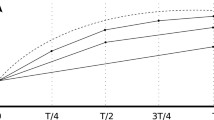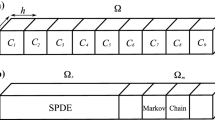Abstract
Stochastic reaction systems with discrete particle numbers are usually described by a continuous-time Markov process. Realizations of this process can be generated with the stochastic simulation algorithm, but simulating highly reactive systems is computationally costly because the computational work scales with the number of reaction events. We present a new approach which avoids this drawback and increases the efficiency considerably at the cost of a small approximation error. The approach is based on the fact that the time-dependent probability distribution associated to the Markov process is explicitly known for monomolecular, autocatalytic and certain catalytic reaction channels. More complicated reaction systems can often be decomposed into several parts some of which can be treated analytically. These subsystems are propagated in an alternating fashion similar to a splitting method for ordinary differential equations. We illustrate this approach by numerical examples and prove an error bound for the splitting error.
Similar content being viewed by others
References
Alfonsi, A., Cancès, E., Turinici, G., Ventura, B.D., Huisinga, W.: Adaptive simulation of hybrid stochastic and deterministic models for biochemical systems. In: ESAIM: Proc., vol. 14, pp. 1–13 (2005)
Anderson, D.F., Ganguly, A., Kurtz, T.G.: Error analysis of tau-leap simulation methods. Ann. Appl. Probab. (2010, to appear). arXiv:0909.4790v2 [math.PR]
Banasiak, J.: A complete description of dynamics generated by birth-and-death problem: a semigroup approach. In: Rudnicki, R. (ed.) Mathematical Modelling of Population Dynamics. Collection of Papers from the Conference, Będlewo, Poland, June 24–28, 2002. Banach Center Publications, vol. 63, pp. 165–176 . Polish Academy of Sciences, Institute of Mathematics, Warsaw (2004)
Burrage, K., Tian, T.: Poisson Runge-Kutta methods for chemical reaction systems. In: Sun, Y.L.W., Tang, T. (eds.) Advances in Scientific Computing and Applications, pp. 82–96. Science Press, Beijing (2004)
Burrage, K., Tian, T., Burrage, P.: A multi-scaled approach for simulating chemical reaction systems. Prog. Biophys. Mol. Biol. 85, 217–234 (2004)
Cao, Y., Li, H., Petzold, L.: Efficient formulation of the stochastic simulation algorithm for chemically reacting systems. J. Chem. Phys. 121, 4059 (2004)
Cao, Y., Gillespie, D.T., Petzold, L.: Multiscale stochastic simulation algorithm with stochastic partial equilibrium assumption for chemically reacting systems. J. Comput. Phys. 206(2), 395–411 (2005)
Cao, Y., Gillespie, D.T., Petzold, L.R.: Avoiding negative populations in explicit Poisson tau-leaping. J. Chem. Phys. 123, 054104 (2005)
Cao, Y., Gillespie, D.T., Petzold, L.R.: The slow-scale stochastic simulation algorithm. J. Chem. Phys. 122, 014116 (2005)
Cao, Y., Gillespie, D.T., Petzold, L.R.: Efficient step size selection for the tau-leaping simulation method. J. Chem. Phys. 124, 044109 (2006)
Descombes, S., Schatzman, M.: Strang’s formula for holomorphic semi-groups. J. Math. Pures Appl. Sér. IX 81(1), 93–114 (2002)
E, W., Liu, D., Vanden-Eijnden, E.: Nested stochastic simulation algorithm for chemical kinetic systems with disparate rates. J. Chem. Phys. 123, 194107 (2005)
Engblom, S.: Numerical Solution Methods in Stochastic Chemical Kinetics. PhD thesis, Uppsala University (2008)
Faou, E.: Analysis of splitting methods for reaction-diffusion problems using stochastic calculus. Math. Comput. 78, 1467–1483 (2009)
Ferm, L., Hellander, A., Lötstedt, P.: An adaptive algorithm for simulation of stochastic reaction-diffusion processes. J. Comput. Phys. 229(2), 343–360 (2010)
Gibson, M.A., Bruck, J.: Efficient exact stochastic simulation of chemical systems with many species and many channels. J. Phys. Chem. A 104(9), 1876–1889 (2000)
Gillespie, D.T.: A general method for numerically simulating the stochastic time evolution of coupled chemical reactions. J. Comput. Phys. 22(4), 403–434 (1976)
Gillespie, D.T.: Approximate accelerated stochastic simulation of chemically reacting systems. J. Chem. Phys. 115, 1716 (2001)
Gillespie, D.T., Petzold, L.R.: Improved leap-size selection for accelerated stochastic simulation. J. Chem. Phys. 119, 8229 (2003)
Goutsias, J.: Quasiequilibrium approximation of fast reaction kinetics in stochastic biochemical systems. J. Chem. Phys. 122, 184102 (2005)
Gradinaru, V.: Strang splitting for the time dependent Schrödinger equation on sparse grids. SIAM J. Numer. Anal. 46, 103–123 (2007)
Hairer, E., Lubich, C., Wanner, G.: Geometric Numerical Integration. Structure-preserving Algorithms for Ordinary Differential Equations, 2nd edn. Springer Series in Computational Mathematics, vol. 31. Springer, Berlin (2006)
Hansen, E., Ostermann, A.: Exponential splitting for unbounded operators. Math. Comput. 78, 1485–1496 (2009)
Hansen, E., Ostermann, A.: High order splitting methods for analytic semigroups exist. BIT 49(3), 527–542 (2009)
Haseltine, E.L., Rawlings, J.B.: Approximate simulation of coupled fast and slow reactions for stochastic chemical kinetics. J. Chem. Phys. 117, 6959 (2002)
Hegland, M.: Approximating the solution of the chemical master equation by aggregation. In: Mercer, G.N., Roberts, A.J. (eds.) Proceedings of the 14th Biennial Computational Techniques and Applications Conference, CTAC-2008, ANZIAM J. 50, C371–C384 (2008)
Hethcote, H.W.: The mathematics of infectious diseases. SIAM Rev. 42(4), 599–653 (2000)
Hundsdorfer, W., Verwer, J.: Numerical Solution of Time-dependent Advection-Diffusion-Reaction Equations. Springer Series in Computational Mathematics, vol. 33. Springer, Berlin (2003)
Jahnke, T.: Splittingverfahren für Schrödingergleichungen. Wiss. Arbeit für das Staatsexamen, Universität Tübingen, Germany (1999)
Jahnke, T.: An adaptive wavelet method for the chemical master equation. SIAM J. Sci. Comput. 31(6), 4373–4394 (2010)
Jahnke, T., Huisinga, W.: Solving the chemical master equation for monomolecular reaction systems analytically. J. Math. Biol. 54(1), 1–26 (2007)
Jahnke, T., Lubich, C.: Error bounds for exponential operator splittings. BIT 40(4), 735–744 (2000)
Li, T.: Analysis of explicit tau-leaping schemes for simulating chemically reacting systems. Multiscale Model. Simul. 6(2), 417–436 (2007)
Lubich, C.: A variational splitting integrator for quantum molecular dynamics. Appl. Numer. Math. 48(3–4), 355–368 (2004)
Lubich, C.: On splitting methods for Schrödinger-Poisson and cubic nonlinear Schrödinger equations. Math. Comput. 77, 2141–2153 (2008)
McAdams, H.H., Arkin, A.P.: Stochastic mechanisms in gene expression. Proc. Natl. Acad. Sci. 94, 814–819 (1997)
McAdams, H.H., Arkin, A.P.: It’s a noisy business! Genetic regulation at the nanomolar scale. Trends Genet. 15, 65–69 (1999)
McLachlan, R.I., Quispel, G.W.: Splitting methods. Acta Numer. 11, 341–434 (2002)
Neuhauser, C., Thalhammer, M.: On the convergence of splitting methods for linear evolutionary Schrödinger equations involving an unbounded potential. BIT 49(1), 199–215 (2009)
Rao, C.V., Arkin, A.P.: Stochastic chemical kinetics and the quasi-steady-state assumption: Application to the Gillespie algorithm. J. Chem. Phys. 118, 4999 (2003)
Rathinam, M., El Samad, H.: Reversible-equivalent-monomolecular tau: a leaping method for “small number and stiff” stochastic chemical systems. J. Comput. Phys. 224(3), 897–923 (2007)
Rathinam, M., Petzold, L.R., Cao, Y., Gillespie, D.T.: Stiffness in stochastic chemically reacting systems: The implicit tau-leaping method. J. Chem. Phys. 119, 12784 (2003)
Rathinam, M., Petzold, L.R., Cao, Y., Gillespie, D.T.: Consistency and stability of tau-leaping schemes for chemical reaction systems. Multiscale Model. Simul. 4(3), 867–895 (2005)
Salis, H., Kaznessis, Y.: Accurate hybrid stochastic simulation of a system of coupled chemical or biochemical reactions. J. Chem. Phys. 122, 054103 (2005)
Solari, H.G., Natiello, M.A.: Stochastic population dynamics: The Poisson approximation. Phys. Rev. E 67, 031918 (2003)
Srivastava, R., You, L., Summers, J., Yin, J.: Stochastic vs. deterministic modeling of intracellular viral kinetics. J. Theor. Biol. 218(3), 309–321 (2002)
Thalhammer, M.: High-order exponential operator splitting methods for time-dependent Schrödinger equations. SIAM J. Numer. Anal. 46(4), 2022–2038 (2008)
Author information
Authors and Affiliations
Corresponding author
Additional information
Communicated by Uri Ascher.
Supported by the “Concept for the Future” of Karlsruhe Institute of Technology within the framework of the German Excellence Initiative, the DFG priority programme SPP 1324 “Mathematische Methoden zur Extraktion quantifizierbarer Information aus komplexen Systemen”, and a grant of the Middle East Technical University, Ankara, Turkey and Selçuk University, Konya, Turkey.
Rights and permissions
About this article
Cite this article
Jahnke, T., Altıntan, D. Efficient simulation of discrete stochastic reaction systems with a splitting method. Bit Numer Math 50, 797–822 (2010). https://doi.org/10.1007/s10543-010-0286-0
Received:
Accepted:
Published:
Issue Date:
DOI: https://doi.org/10.1007/s10543-010-0286-0
Keywords
- Stochastic simulation algorithm
- Discrete stochastic reaction systems
- Splitting methods
- Analytic solution formulas
- Error bounds
- Chemical master equation




